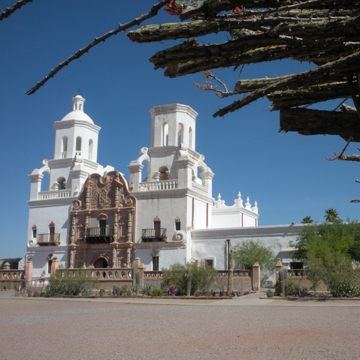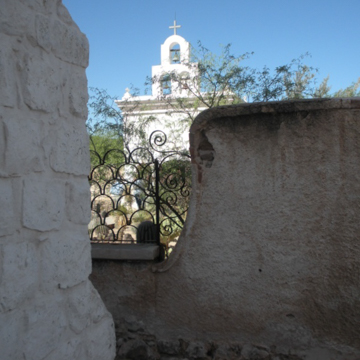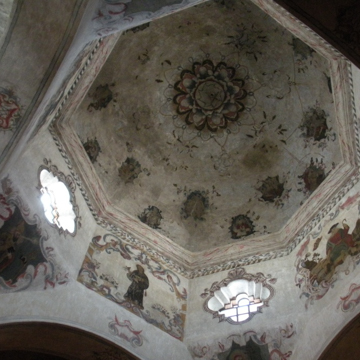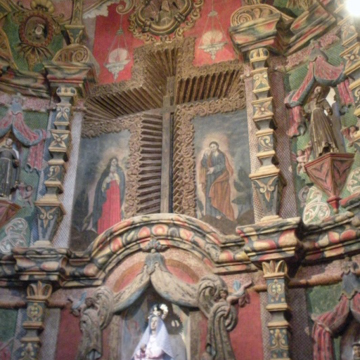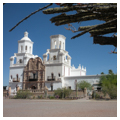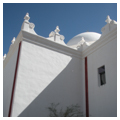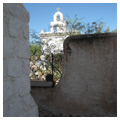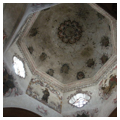You are here
Mission San Xavier del Bac
One of the finest examples of Spanish Colonial architecture in the United States, Mission San Xavier del Bac, built over two centuries ago on the present-day Tohono O’odham San Xavier Indian Reservation, remains a functioning parish church as well as a vestige of the American Southwest’s Spanish colonial history.
Eusebio Francisco Kino (1645–1711), born in a small town near the Italian Alps, survived a serious illness and dedicated his life to religious service. He declined a teaching position in mathematics at Austria’s University of Ingolstadt to answer the Roman Catholic Church’s call to convert the “aborigines” of northern New Spain. The Jesuit priest crisscrossed Baja California (thereby establishing conclusively that Baja California was a peninsula and not an island), north-central Mexico, and Arizona, preaching, mapping, and founding as many as 20 missions until his death at age 65. He surveyed land in the Santa Cruz Valley for a mission as early as 1697; by 1700, Kino had laid the cornerstones for a small church he named in honor of St. Francis Xavier (one of the first Jesuits) in the Tohono O’odham village of Bac (meaning “where the waters gather” in the O’odham language). In addition to laying the groundwork for San Xavier, he founded Tumacacori, a sister mission, now in ruins near Tubac, 40 miles due south.
After King Charles III expelled the Jesuits from the Spanish empire in 1767, the Franciscans were given oversight of all missions in the Pimeria Alta. Although the Jesuits had been successful as missionaries, they were not known for their building prowess. Construction began on the present church at San Xavier in 1783 under the direction of Father Juan Bautista Velderrain, who did not live to see its completion. Kino’s and Velderrain’s dream was finally realized by Father Juan Bautista Llorens, who oversaw the completion of the church in 1797.
The “White Dove of the Desert” is thought to have been designed by master builder Ignacio Gaona who combined Byzantine, Moorish, and late Mexican Baroque elements with native motifs, blending all of them together into a unified composition with a “Churrigueresque” flair. The footprint, laid out on the site Kino had designated, is a traditional cruciform plan. The building form is distinguished by a massive, 52-foot-high, flattened dome at the crossing and lower ovoid domes over the nave and transept arms. Most prominent visually are two 80-foot bell towers. Both towers are supported by flying buttresses embellished with fanciful scrolls; the west tower is crowned by a dome and lantern. The east tower remains unfinished. Most likely, the builders simply ran out of money, though they may have emulated Medieval European cathedrals in which symmetrical towers were rare, due to long building campaigns. Here, however, legend has it that during construction a worker fell to his death from the east tower and that his superstitious coworkers refused to finish it.
The church’s facade consists of a central pavilion of imaginatively detailed sandstone, carved with volutes, shells, bas relief figures, and arabesques of Moorish and Mexican Baroque influence flanked by whitewashed bays with relatively few decorative elements. The interior is covered by frescoes and stenciled images and filled with statuary. Local Tohono O’odham natives and professional artists contributed to the amazing assemblage, which includes many trompe l’oeil pieces, such as the blue and white tiles painted on the nave’s walls, a fake door that maintains symmetry by matching a real one on the opposite side of the altar, a faux cord supporting a framed painting that is actually a fresco, and the nave’s ribbed domes which imitate folds of cloth. Inside and out, birds and animals are frequent subjects. Handles on the sanctuary doors resemble rattlesnakes ready to strike, while serpents can be found in niches in the walls. A cat perched above the west volute flanking the exterior main entry fixes its glare on a mouse atop the east volute. According to local lore, the end of the world will come when the cat catches the mouse. Lions guard the sanctuary, and grapes, wheat, watermelon, and flowers are also represented in relief. Brilliant red pigments derived from ocotillo roots, vibrant blues from the pulpy saguaro sap, browns and yellows from beneath the bark of palo verde trees, green hues extracted from sage, and black from mesquite beans energize the artwork. Unusual patterns of blue dots, formed by native artisans dipping their thumbs into vegetable dye and pressing them onto the plaster, add a level of abstraction.
The Franciscans, with their Mexican and Native American laborers, had only local building materials at their disposal. Volcanic stones, gathered from the neighboring hills, and concrete were mixed onsite to form foundations extending five feet below ground level and two feet above. The limestone-plastered, double-width walls of fired adobe brick with rubble rock infill are representative of a technique dating back to the Roman occupation of Spain. Lime was extracted from local limestone deposits to use in making the plaster, which consisted of a traditional mixture of milk, caliche, and animal blood. Pine used for the woodwork originated in the forests of the Santa Catalina Mountains, as did oak for the entry doors, while old growth mesquites were used for the altar railing and pulpit.
The mission of San Xavier del Bac was abandoned in 1828, when the newly independent Mexican government expelled the Franciscans. Sometime after the 1853 Gadsden Purchase, in which the territory south of the Gila River was transferred from Mexico to the United States, the area became part of the Roman Catholic Diocese of Santa Fe. Priests began visiting the mission again and some of the church’s sacramental (and valuable) objects, which the retreating Franciscan clergy had entrusted to locals, reappeared.
During the late nineteenth century, the church withstood earthquakes, lightning strikes, and severe weather. By 1900 it was beginning to show signs of age; at this time, there were several attempts to repair cracks in the main dome and expand some of the ancillary buildings. By the late 1940s, the need for further restoration work was obvious, and architect Eleazar Herreras oversaw a limited effort. Because the exuberant colors animating the artwork had begun to fade, an unfortunate restoration attempt was undertaken by artist Henry Milan, who painted over some of the original decorations with oil-based pigment, topped with varnish. In the late 1980s, when pieces of plaster began dropping into the sanctuary, it was discovered that patches of Portland cement from earlier repairs had trapped moisture inside the walls. This prevented the surfaces from breathing and caused the plaster to crack and fall.
Concerned citizens formed a non-profit organization to raise funds and address the deterioration. The group, Patronato San Xavier, retained Paul Schwartzbaum, chief conservator of the Solomon P. Guggenheim Museum of Art in New York City, and an international team of conservators to save the church’s structure and its art. To save the wall painting, Japanese rice paper soaked in denatured alcohol was applied to release the long-accumulated dirt. The offending oil paint and varnish were removed with lacquer thinner, while layers of dust, candle soot, and bird excrement were erased with clear water or special dry sponges. An adhesive was then injected through syringes to reattach any loose plaster. The deteriorated cement patchwork was replaced by applying a new “skin” made of traditional lime, sand, and a “glue” produced from nopals (prickly pear cactus lobes). The roof’s exterior surface was burnished with river rock to retard moisture penetration. Small-scale restoration efforts continue today under the aegis of local architect Robert Vint, who began working with Patronato San Xavier in the 1990s. Tohono O’odham tribal members serve as the restoration workforce, learning conservation techniques to pass on to future generations.
In addition to the church itself, the mission complex includes a small, white mortuary chapel (1796), monastery buildings (1994), and an enclosed patio.
References
Durham, Michael S. Smithsonian Guide to Historic America: The Desert States.New York: Stewart, Tabori and Chang, 1990.
Ettenborough, Kelly. Arizona’s Sanctuaries, Retreats and Sacred Spaces.Englewood, CO: Westcliffe publishers, 2003.
Hall, Douglas Kent. Frontier Spirit: Early Churches of the Southwest.New York: Abbeville Press, 1990.
Kennedy, Roger G. Mission: The History and Architecture of the Missions of North America.New York: Houghton Mifflin, 1990.
Larew, Marilyn, “San Xavier del Bac Mission,” Pima County, Arizona. National Register of Historic Places Inventory-Nomination Form, 1978. National Park Service, U.S. Department of the Interior, Washington, DC.
Nequette, Anne M., and R. Brooks Jeffery. A Guide to Tucson Architecture. Tucson: University of Arizona Press, 2002.
Parachek, Ralph. Desert Architecture.Phoenix: Parr of Arizona, 1967.
Patterson, Ann, and Mark Vinson. Landmark Buildings: Arizona’s Architectural Heritage.Phoenix: Arizona Highways, 2004.
“Patronato Mission San Xavier del Bac.” Accessed January 1, 2015. www.patronatosanxavier.org.
Sanford, Trent Ellwood. The Architecture of the Southwest.Tucson: University of Arizona Press, 1950.
Smith, G.E. Kidder. Source Book of American Architecture.New York: Princeton Architectural Press, 1996.
Walker, Kathleen. San Xavier: The Spirit Endures.Phoenix: Arizona Highways, 1998.
Writing Credits
If SAH Archipedia has been useful to you, please consider supporting it.
SAH Archipedia tells the story of the United States through its buildings, landscapes, and cities. This freely available resource empowers the public with authoritative knowledge that deepens their understanding and appreciation of the built environment. But the Society of Architectural Historians, which created SAH Archipedia with University of Virginia Press, needs your support to maintain the high-caliber research, writing, photography, cartography, editing, design, and programming that make SAH Archipedia a trusted online resource available to all who value the history of place, heritage tourism, and learning.




















